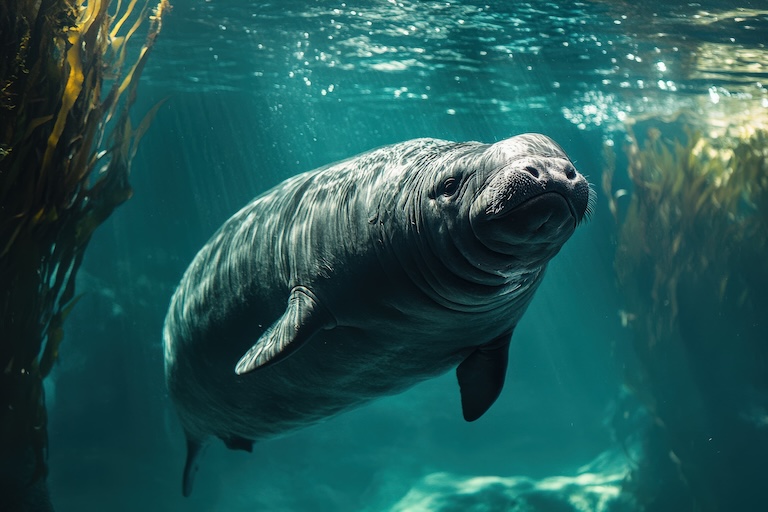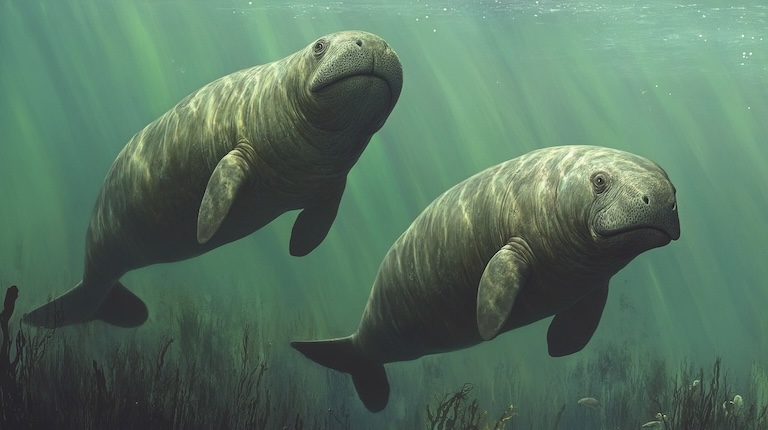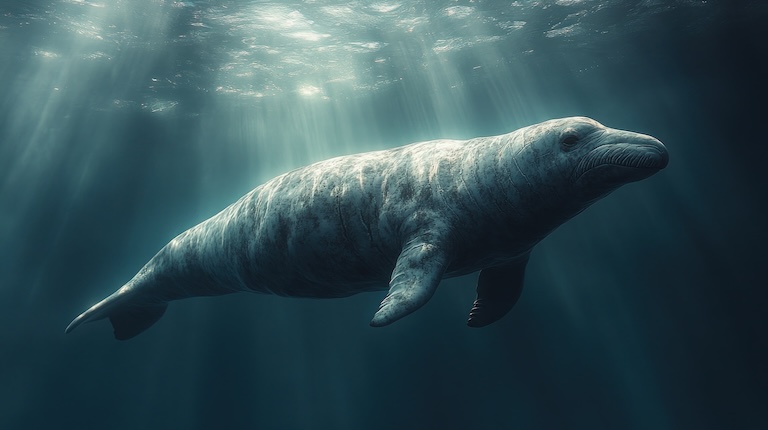Steller’s Sea Cow Profile
The recent history and brief co-existence of the Steller’s Sea Cow alongside modern Europeans can perhaps be summed up best by the guy who named it, Georg Steller, who described the animal as: “Tasty”.

Steller’s Sea Cow Facts Overview
| Habitat: | Shallow waters |
| Location: | North Pacific |
| Lifespan: | Unknown |
| Size: | 10m (33ft) long |
| Weight: | Possible exceeding 11 tons |
| Colour: | Grey |
| Diet: | Sea grasses, kelp |
| Predators: | Humans |
| Top Speed: | Unknown |
| No. of Species: | 1 |
| Conservation Status: | Extinct |
This close relative of the extant dugong was busy minding its own business in the shallow kelp forests of a few islands in the North Pacific, when fur hunters, looking for otters discovered and devoured it in less than three short decades.
The largest of the sirenians, and bigger than many whale species, this gargantuan was a tired relic from the Pleistocene, cut off from its peers by rising sea levels, and genetically too unvaried to have been viable for much longer.
Still, its loss has affected the ecosystem and is a reminder of the damage that the wake of a single species can leave.
Interesting Steller’s Sea Cow Facts
1. The least convincing of all the Sirenians
Manatees and dugongs, and the extinct sea cow are all grouped into the order Sirenia, so named after the mythical beings from Greek legends, who were said to have such alluring voices that lonely sailors would be drawn to their deaths on the rocks in pursuit of them.
There’s a lot of overlap in these legends between sirens and mermaids, but one thing they typically had in common was a very appealing human woman half, that, for a sailor who’d been on a very long voyage, would prove irresistible.
It’s thought that the Sirenians may have been the inspiration for these legends, despite being – and this is no slight on them; they were probably lovely – ugly as hell.
The Steller’s Sea cow, as the largest of the Sirenians, might then have appealed only to a very niche market of sailors, but then there’s no telling how much a touch of scurvy, dehydration, and months of endless emptiness can lower the bar for a person.
They had extended lips and skin like “the bark of an old oak tree”. Regardless, a ten-meter-long, 11-ton cylinder of sexy blubber and whiskers seductively wallowing in the shallows must have been a challenge for even the most desperate of seamen. 1 2

2. But they did have a certain undeniable appeal
Back in the day, naturalists went around the world documenting various details about animals, much as they still do today. One thing that’s gone a bit out of fashion in recent years, however, is the details of what these discoveries taste like.
Botanists probably have it easier in this regard, but it wasn’t that long ago that biologists would supplement their field notes with various culinary annotations.
The Glutton Club, formed by none other than Charles Darwin, was a famous example of biologists whose goal was to taste various “birds and beasts which were before unknown to human palate”, and the unfortunate Steller’s Sea Cow was an unfortunate victim of similar such detailed research.
Named after (and by) Georg Steller, the German explorer who discovered it, this sea cow joined the ranks of more or less everything else the guy discovered in acquiring his namesake. Alongside such important data as its size, shape, and appendages, were comments such as “tasty”, and “similar to corned beef”.
The vast amounts of blubber meant the meat could be cooked in its own fat, which supposedly tasted like almond oil, and even the milk of female sea cows was made into butter or drunk neat.
Their thick skin was also useful as hide, and their blubber could be rendered into lamp oil. All in all, this was a large and accessible resource to the 18th-century whalers, and they jumped all over it. 3
3. They were huge
Large may be an understatement, as these enormous animals were likely the biggest non-cetacean of the time.
Common reports claim they reached well over 7 meters long, and most agree that their upper limit would have been around 8 to 10 meters long, with a weight of up to around 11 tons.
They had immensely thick blubber and skin, especially on the limbs, which they used to pull themselves along the sea bed in the shallows. Some say it was so blubbery that it couldn’t dive at all, instead bobbing about on the surface.
But this didn’t seem to stop it from being a once-prolific presence in the ocean.
4. They once ranged across the North Pacific
Fossil records show us this species had a far greater ranger than what was known to modern explorers by the 18th century.
By the time it was recorded by the hungry explorer Georg, there may have only been 1500 individuals remaining, relegated to the shallow kelp beds around a handful of Islands in the Bering Sea.
But during the Pleistocene, it’s thought to have had a much wider and therefore more significant ecological range and impact.
Still, fossils are few and far-between, and the jury is still out as to whether this is true, or if the fossils found are of another sirenian altogether.
Almost all of what we know about Steller’s Sea cow comes from the brief period of overlap between it and the Europeans who exploited it.

5. They were remarkably short-lived
At least as far as their presence in the literature goes, this tasty lump of sailor bait was extinct within thirty years of being discovered by Europeans.
Records show that these likely slow and defenceless giants were hunted with reckless abandon, at seven times the sustainable limit.
Almost as soon as they were discovered, they were killed off in their entirety as yet another ecological resource was mistakenly perceived as infinite, but there may be more to their extinction than meets the eye.
While they were no doubt finished off by humans, it’s very likely they were already well on their way to extinction before this. 4
6. Extinction debt
Humans have a well-deserved reputation for killing off large mammals within a short period after becoming neighbours with them, but it’s important to acknowledge that there are other factors that result in extinctions, too.
While we probably would have found and killed the rest of them eventually, by the time overhunting wiped out the last few, their numbers had been in steep decline for a long time.
Recent genetic analyses suggest their populations had been constricted, perhaps for thousands of years, and their gene pool wasn’t particularly healthy as a result.
Massive changes in climate at the end of the ice age likely led to fragmented populations, most of which didn’t survive. The remaining populations, with their genetic diversity decimated, would have represented what’s known as a dead clade walking, or an extinction debt.
This essentially meant their days were numbered, and it was just a matter of time until they disappeared, one way or another. 5
7. And this likely caused a cascade of effects
Removing anything this large from the ecosystem will always have a resounding effect that changes the course of history.
While it’s not thought that this sea cow was holding its ecosystem together as some species do, the large amounts of biomass and corresponding sea cow poop would have done a lot to maintain the health of the kelp forests they once inhabited.
With every loss, there’s a knock-on effect on the environment, and reductions in biodiversity lead to reductions in resilience in the ecosystem.
It’s now thought that the resilience of the kelp forests in the North Pacific has been reduced as a result of their loss, and this shines a light on many of the broader implications of ongoing population losses all over the world. 6 7
Steller’s Sea Cow Fact-File Summary
Scientific Classification
| Kingdom: | Animalia |
| Phylum: | Chordata |
| Class: | Mammalia |
| Order: | Sirenia |
| Family: | Dugongidae |
| Genus: | Hydrodamalis |
| Species: | gigas |
Fact Sources & References
- Anderson, Paul K (2018), “Steller’s Sea Cow”, Sci-Hub.
- News Staff (2022), “Genetic Secrets of Steller’s Sea Cow Revealed”, Sci News.
- Bret Weinstein, “Hydrodamalis gigas”, Animal Diversity Web.
- S.T Turvey (2006), “Modelling the extinction of Steller’s sea cow”, NIH.
- Fedor S. Sharko (2021), “Steller’s sea cow genome suggests this species began going extinct before the arrival of Paleolithic humans”, nature communications.
- Peter D. Roopnarine, “Impact of the extinct megaherbivore Steller’s sea cow (Hydrodamalis gigas) on kelp forest resilience”, frontiers.
- Skylar Knight (2022), “Researchers reveal how extinct Steller’s sea cow shaped kelp forests”, Phys Org.
